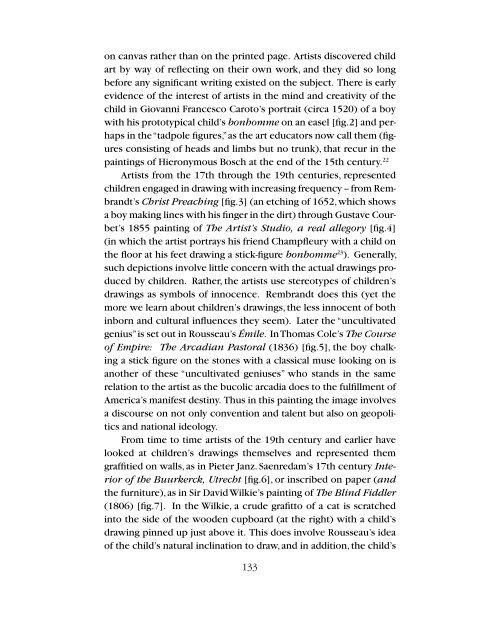Jonathan Fineberg – The Postman Did It – Children’s Art and the Avant-garde
Excerpt from “A Kid Could Do That!”, an extensive publication prepared by Galerie Gmurzynska on the occasion of the large-scale eponymous exhibition project at Art Basel Miami Beach 2014, conceived with Hollywood luminaries Baz Luhrmann and Catherine Martin.
Excerpt from “A Kid Could Do That!”, an extensive publication prepared by Galerie Gmurzynska on the occasion of the large-scale eponymous exhibition project at Art Basel Miami Beach 2014, conceived with Hollywood luminaries Baz Luhrmann and Catherine Martin.
- No tags were found...
Create successful ePaper yourself
Turn your PDF publications into a flip-book with our unique Google optimized e-Paper software.
on canvas ra<strong>the</strong>r than on <strong>the</strong> printed page. <strong>Art</strong>ists discovered child<br />
art by way of reflecting on <strong>the</strong>ir own work, <strong>and</strong> <strong>the</strong>y did so long<br />
before any significant writing existed on <strong>the</strong> subject. There is early<br />
evidence of <strong>the</strong> interest of artists in <strong>the</strong> mind <strong>and</strong> creativity of <strong>the</strong><br />
child in Giovanni Francesco Caroto’s portrait (circa 1520) of a boy<br />
with his prototypical child’s bonhomme on an easel [fig.2] <strong>and</strong> perhaps<br />
in <strong>the</strong> “tadpole figures,” as <strong>the</strong> art educators now call <strong>the</strong>m (figures<br />
consisting of heads <strong>and</strong> limbs but no trunk), that recur in <strong>the</strong><br />
paintings of Hieronymous Bosch at <strong>the</strong> end of <strong>the</strong> 15th century. 22<br />
<strong>Art</strong>ists from <strong>the</strong> 17th through <strong>the</strong> 19th centuries, represented<br />
children engaged in drawing with increasing frequency -- from Rembr<strong>and</strong>t’s<br />
Christ Preaching [fig.3] (an etching of 1652, which shows<br />
a boy making lines with his finger in <strong>the</strong> dirt) through Gustave Courbet’s<br />
1855 painting of The <strong>Art</strong>ist’s Studio, a real allegory [fig.4]<br />
(in which <strong>the</strong> artist portrays his friend Champfleury with a child on<br />
<strong>the</strong> floor at his feet drawing a stick-figure bonhomme 23 ). Generally,<br />
such depictions involve little concern with <strong>the</strong> actual drawings produced<br />
by children. Ra<strong>the</strong>r, <strong>the</strong> artists use stereotypes of children’s<br />
drawings as symbols of innocence. Rembr<strong>and</strong>t does this (yet <strong>the</strong><br />
more we learn about children’s drawings, <strong>the</strong> less innocent of both<br />
inborn <strong>and</strong> cultural influences <strong>the</strong>y seem). Later <strong>the</strong> “uncultivated<br />
genius” is set out in Rousseau’s Émile. In Thomas Cole’s The Course<br />
of Empire: The Arcadian Pastoral (1836) [fig.5], <strong>the</strong> boy chalking<br />
a stick figure on <strong>the</strong> stones with a classical muse looking on is<br />
ano<strong>the</strong>r of <strong>the</strong>se “uncultivated geniuses” who st<strong>and</strong>s in <strong>the</strong> same<br />
relation to <strong>the</strong> artist as <strong>the</strong> bucolic arcadia does to <strong>the</strong> fulfillment of<br />
America’s manifest destiny. Thus in this painting <strong>the</strong> image involves<br />
a discourse on not only convention <strong>and</strong> talent but also on geopolitics<br />
<strong>and</strong> national ideology.<br />
From time to time artists of <strong>the</strong> 19th century <strong>and</strong> earlier have<br />
looked at children’s drawings <strong>the</strong>mselves <strong>and</strong> represented <strong>the</strong>m<br />
graffitied on walls, as in Pieter Janz. Saenredam’s 17th century Interior<br />
of <strong>the</strong> Buurkerck, Utrecht [fig.6], or inscribed on paper (<strong>and</strong><br />
<strong>the</strong> furniture), as in Sir David Wilkie’s painting of The Blind Fiddler<br />
(1806) [fig.7]. In <strong>the</strong> Wilkie, a crude grafitto of a cat is scratched<br />
into <strong>the</strong> side of <strong>the</strong> wooden cupboard (at <strong>the</strong> right) with a child’s<br />
drawing pinned up just above it. This does involve Rousseau’s idea<br />
of <strong>the</strong> child’s natural inclination to draw, <strong>and</strong> in addition, <strong>the</strong> child’s<br />
133

















